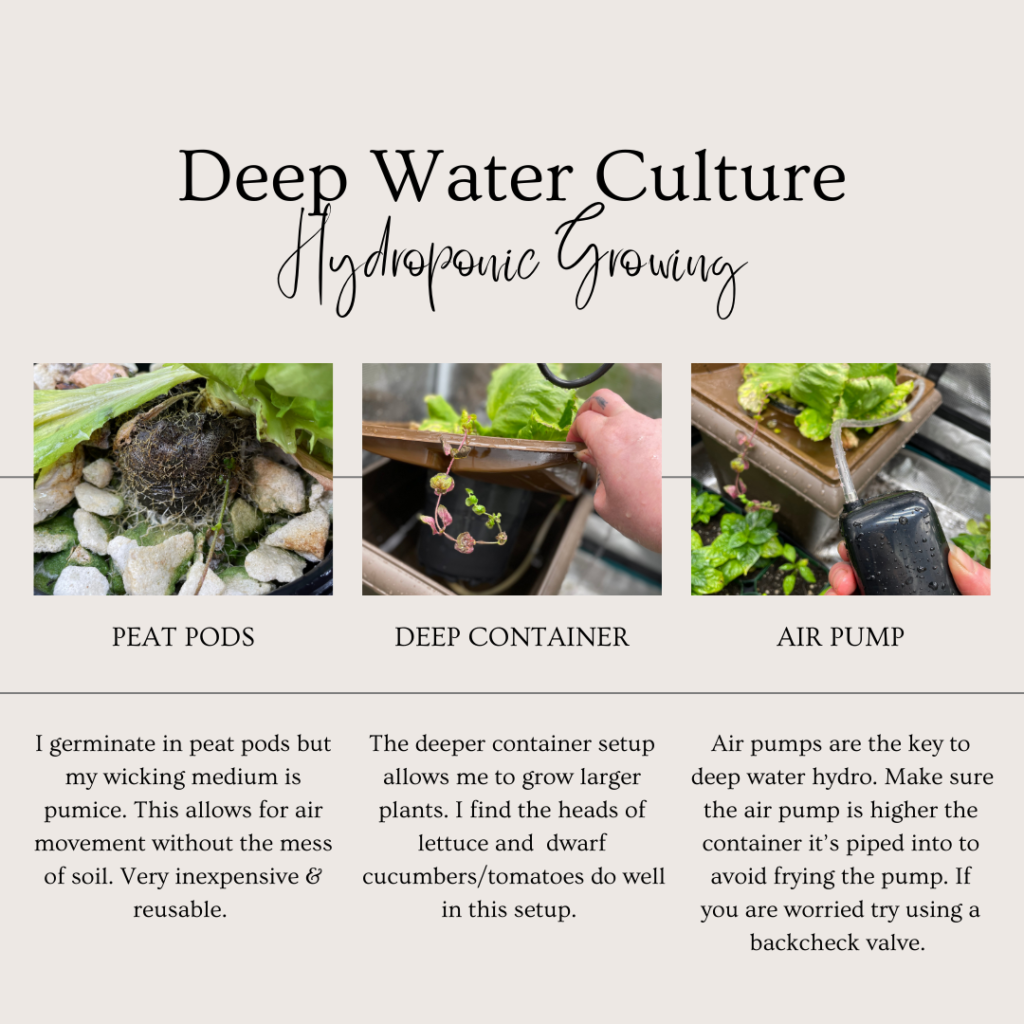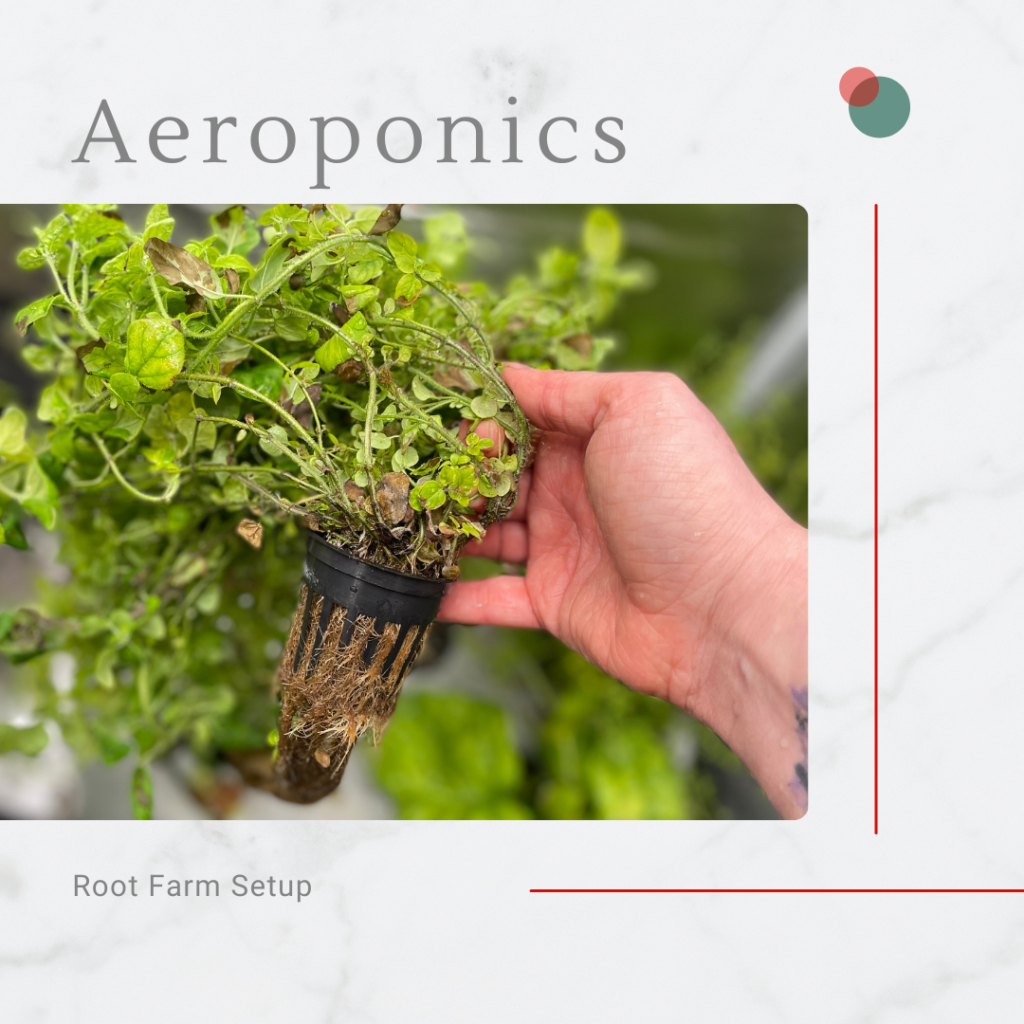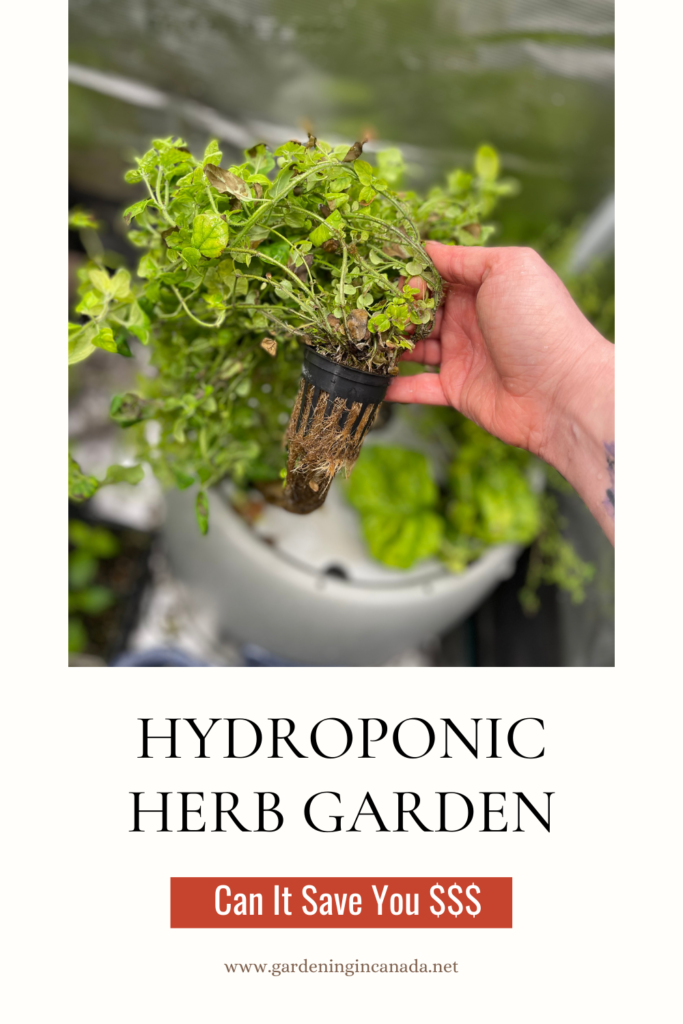- Canada’s Growing Zones Are Changing 2024 - January 12, 2024
- Attracting Wildlife To The Garden - May 16, 2023
- How To Garden Near A Septic Tank - May 9, 2023
Hydroponic growing is the key for anyone who wants a continuous supply of herbs and leafy greens. This article is going to go over a hydroponic herb garden and different setup options.
If you are new to this blog my name is Ashley and I am a soil scientist. I am located in a Canadian Zone 3 and a USDA Zone 4. I write articles, make YouTube videos, Instagram & Facebook posts all designed for Canadians and Cold Climate gardeners using science-based methods. If you are looking for anything specific be sure to let me know in the comments down below.
Is hydroponics worth the investment for just growing herbs?
This answer is going to depend on how much you use fresh herbs in your home. Therefore, if you go through a bundle of fresh herbs a week then you are likely spending around $280 dollars a year. This means it will pay for itself within the first year of owning the setup.
If you are looking to do your own dried herbs and a container runs you around $10 each. It will depend on how often you use a container of dried herbs. Moreover, you can expect a drying harvest once every three months so you are likely to make $40 worth of dried herbs a year per plant. In my root farm container, this comes out to $160 of dried herbs a year. This means your setup would take two years to pay off with herb production.
Why Is Hydroponic Herb Garden Growing Better Than Soil?
The reason why you may consider doing hydroponics comes down to the fact that it is mess-free and perfect for small spaces. Hydroponics is unique in the sense that it can provide water, nutrients and oxygen directly to the plant roots without the middleman. The middleman in most cases is our soil.
If the soil is not at the optimal moisture levels then oxygen, nutrients and water are not being properly delivered. This lack of optimization ultimately can slow down growth. And this is why with hydroponics we generally see rapid growth. This means faster harvests and higher yields than soil-produced plants.
There are a few different options when it comes to growing hydroponically. Each system yields different results and is designed for different plants. Let’s go through each system type to help you determine which option works best for your family. If find that hydroponic herb garden setups tend to have the largest savings.
Wicking Hydroponics
This is commonly used with houseplants and is often called semi-hydroponics. The label semi hydroponics is not the most accurate description because it is a form of full hydroponics. The wicking form of hydroponics is not just reserved for houseplants but also smaller vegetative plants. This can be used with herbs and leafy greens and yield great results.
The best medium for this system would be pumice, LECA or perlite. Something airy and larger will allow for optimal levels of oxygen, nutrients and water without the use of a pump or aeration. If you use this type of system it is important to use the correct fertilizing regime and ensure your pH is neutral. We will look at exactly what this means a little later on.
Options that use soil and wicking mats are also available for those trying to grow just herbs. The most common brand for this is the sun blaster setup. I find that using soil indoors can become messy so I generally try to avoid it.
Deepwater Culture Hydroponics
The deepwater culture hydro setups are inexpensive and can be made with nearly anything. It is common for people to use five-gallon buckets with a hole cut into the lid. The key here is that there is a bubbler placed into the water allowing for oxygenation. This system works great for herbs, leafy greens and some smaller pepper plants.
The important thing to remember here is that the bubbler needs to be higher than the water level or a backcheck valve needs to be installed. It is not uncommon for the water to run up the hose and into the motor damaging it.
In my deepwater culture setup, I germinated my seeds in peat pods. I find this to be the most effective as it allows water to move between the pumice medium into the peat pod easily. If I was to germinate directly into the pumice I run the risk of the seed falling too far down in the basket.

NFT Hydroponics
This is the classic PVC piping hydroponic system we commonly see in a larger setup. This is simply a recirculating system that ensures you do not suffocate your roots. This system relies on water constantly being pumped through the piping which means if the pump malfunctions the crop can be ruined.
The other common issue is that roots can intertwine and also cause blockages over time. This setup is perfect for any sort of plant both long-term and short-term growth habits. If you intend to use it for plants that grow for extended periods keep in mind proper fertilizer application is key to ensuring the plumbing doesn’t get clogged up.
Aeroponics – Hydroponic Herb Garden Favourite
This is the most common in-home option and is what the Garden Towers, Rise Gardens, & Root Farm System. They are the most expensive setup but also the most effective at producing food quickly. The system is essentially using a nozzle to mist or spray suspended plant trays. The mix of water and oxygen allows for healthy and quick plant development.
The key here again is proper fertilizer applications and cleaning out the system after each use. This will help extend the life of the system while producing healthy food to ensure it was worth your money.

Hydroponic Growing Media
The growing media in a hydroponic system is typically soilless to help lessen the risk of clogs. Some options will work as a stand-alone product that holds their shape and others may require a special basket or fine mesh material. Materials that can be placed into a basket include:
- Rockwool – My second favourite
- Stonewool – Least favourite
- LECA – Third favourite
- Gravel – Never Tried
- Root Farm Pods – What I use
Materials that will require a mesh netting and a basket include:
- Vermiculite
- Perlite
- Coconut coir
- Peat moss
The medium you choose is completely up to you. I use a form of sponge that looks like a plug and plops into the hydro baskets. The goal is to use the most mess-free option that you are comfortable with. Both the basket and the growing medium after growing a plant can be composted and should not be reused.
Hydroponic Fertilizer
This is the most important aspect of hydroponically growing food and can sometimes be intimidating. I recommend going for the simplest fertilizing system and avoiding anything with multiple bottles of micronutrients. The root farm fertilizing setup is one of the easiest hydroponic fertilizing systems. There are a total of four options:
- Base – You will need this bottle for everything
- All-Purpose – This is for herbs, leafy greens, and root veggies
- Flower – This is for anything that flowers such as orchids
- Veggies – This will be for tomatoes, peppers and other fruiting plants
Regardless of what you are growing, you will need to grab a base bottle as this contains the base nutrients needed by all plants regardless of their growth habit. From there you will need to select the applicable bottle based on what you are trying to grow. If you are doing herbs and peppers in the same system simply go with the fruit bottle because this will work for both plant types.
When mixing for your fertilizing setup you want to always add the water and fertilizer together first. Follow the dosing recommendations on the fertilizer packages and keep in mind that the volume of fertilizer may be dependent on the plant’s growth stage. After everything is mixed together you can begin testing for the pH of the water.
Is pH Important With Hydroponics
pH testing of the water and the adjustments afterwards are an absolute must. Plants both in the soil and in hydro systems need specific pH ranges for nutrient absorption. If the pH range is above or below a 6-7 we have restricted nutrient uptake and stunted growth.
To make adjustments to the water’s pH you will want to use pH up or pH down. This normally is a liquid and a little bit goes a very long way. Just a few drops can adjust the pH by several points. You will need to recheck your pH after adding the adjustments to ensure you have hit the proper levels.
Once the water & fertilizer mixture is sitting between 6-7 pH you can add it to the system. If there is water left over feel free to water your other potted plants with the mixture. Or if you have a container with a lid you can store it long-term to reuse.
This is a list of what you will need for testing your hydroponic herb garden water
Cleaning Your Hydroponic System
This tends to be specific to the manufacturer and I always recommend using their instructions for cleaning. This will ensure the longest lifespan of the system itself. If you are ever in doubt, warm water and a bit of elbow grease are always your best bet. For difficult to remove build the use of hydrogen peroxide is always helpful and a non-toxic option.
If the system is mostly plastic you want to avoid using anything that can scratch. This means using gentle sponges and avoiding wire or hard plastic brushes.
Hydroponic Herb Garden Lighting
This is going to depend on what look you are going for. You can simply do a clamp lamp with a single bulb or something more elaborate. Below are some options for lighting that would work:
- Small Hydroponic Herb Garden Lighting – The ability to adjust the height of the light is the key feature of this lighting.
- Sunblaster Daisy Chain Setup – Ideal for anyone looking to start small and grow their setup over time. This light allows for a daisy chain setup which means you can add lights without more plug-ins.
- Single Light Bulbs For Light Fixtures Or Clamp Lamp such as this one here.
- Large footprint light for growing larger plants.
My Favourite Hydroponic Herb Garden Setup
My favourite setup is hands down the root farm system because it seems to be the highest yielding and easiest to maintain.
The root farm system easily pays for itself within 6 months of growing herbs.
Seed Starting In A Hydroponic Herb Garden
For this, I like to start everything outside of my hydro setup and inside the medium. My favourite medium for the root farm setup is the root farm plugs. For the Jiffy hydro deep water culture method, I like to use jiffy peat pods.
Overall hydroponics is perfect for delivering water and nutrients in optimal proportions. This means the plants can grow faster than what we are used to. I love using mine for herbs and leafy greens because it’s a continuous supply. Let me know what you love about hydroponics and your favourite system.

